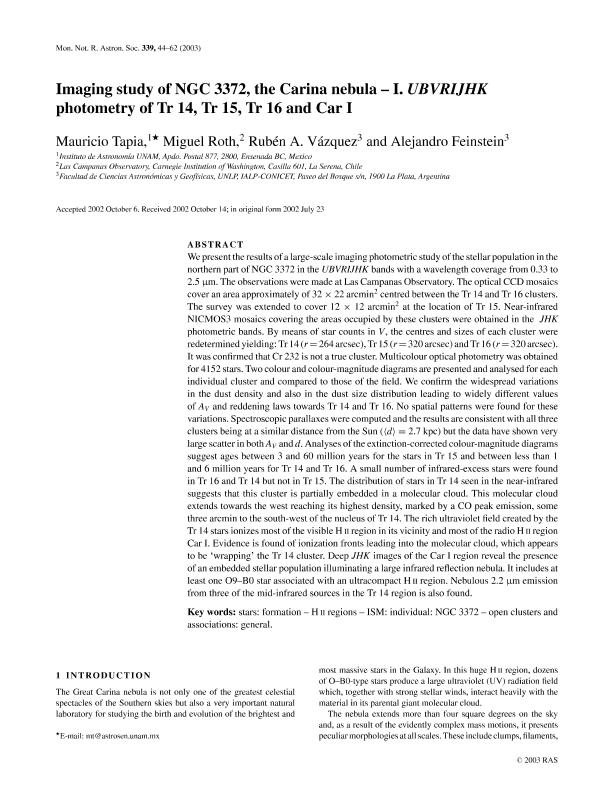Mostrar el registro sencillo del ítem
dc.contributor.author
Tapia, Mauricio Andres

dc.contributor.author
Roth, Miguel
dc.contributor.author
Vazquez, Ruben Angel

dc.contributor.author
Feinstein, Alejandro

dc.date.available
2018-02-19T21:48:11Z
dc.date.issued
2003-02
dc.identifier.citation
Tapia, Mauricio Andres; Roth, Miguel; Vazquez, Ruben Angel; Feinstein, Alejandro; Imaging study of NGC 3372, the Carina nebula -I. UBVRIJHK photometry of Tr 14, Tr 15, Tr 16 and Car I; Wiley Blackwell Publishing, Inc; Monthly Notices of the Royal Astronomical Society; 339; 1; 2-2003; 44-62
dc.identifier.issn
0035-8711
dc.identifier.uri
http://hdl.handle.net/11336/36798
dc.description.abstract
We present the results of a large-scale imaging photometric study of the stellar population in the northern part of NGC 3372 in the UBVRIJHK bands with a wavelength coverage from 0.33 to 2.5 μm. The observations were made at Las Campanas Observatory. The optical CCD mosaics cover an area approximately of 32 × 22 arcmin2 centred between the Tr 14 and Tr 16 clusters. The survey was extended to cover 12 × 12 arcmin2 at the location of Tr 15. Near-infrared NICMOS3 mosaics covering the areas occupied by these clusters were obtained in the JHK photometric bands. By means of star counts in V, the centres and sizes of each cluster were redetermined yielding: Tr 14 (r = 264 arcsec), Tr 15 (r = 320 arcsec) and Tr 16 (r = 320 arcsec). It was confirmed that Cr 232 is not a true cluster. Multicolour optical photometry was obtained for 4152 stars. Two colour and colour-magnitude diagrams are presented and analysed for each individual cluster and compared to those of the field. We confirm the widespread variations in the dust density and also in the dust size distribution leading to widely different values of AV and reddening laws towards Tr 14 and Tr 16. No spatial patterns were found for these variations. Spectroscopic parallaxes were computed and the results are consistent with all three clusters being at a similar distance from the Sun (〈d〉 = 2.7 kpc) but the data have shown very large scatter in both AV and d. Analyses of the extinction-corrected colour-magnitude diagrams suggest ages between 3 and 60 million years for the stars in Tr 15 and between less than 1 and 6 million years for Tr 14 and Tr 16. A small number of infrared-excess stars were found in Tr 16 and Tr 14 but not in Tr 15. The distribution of stars in Tr 14 seen in the near-infrared suggests that this cluster is partially embedded in a molecular cloud. This molecular cloud extends towards the west reaching its highest density, marked by a CO peak emission, some three arcmin to the south-west of the nucleus of Tr 14. The rich ultraviolet field created by the Tr 14 stars ionizes most of the visible H II region in its vicinity and most of the radio H II region Car I. Evidence is found of ionization fronts leading into the molecular cloud, which appears to be 'wrapping' the Tr 14 cluster. Deep JHK images of the Car I region reveal the presence of an embedded stellar population illuminating a large infrared reflection nebula. It includes at least one O9-B0 star associated with an ultracompact H II region. Nebulous 2.2 μm emission from three of the mid-infrared sources in the Tr 14 region is also found.
dc.format
application/pdf
dc.language.iso
eng
dc.publisher
Wiley Blackwell Publishing, Inc

dc.rights
info:eu-repo/semantics/openAccess
dc.rights.uri
https://creativecommons.org/licenses/by-nc-sa/2.5/ar/
dc.subject
H &Prod; Regions
dc.subject
Ism: Individual: Ngc 3372
dc.subject
Open Clusters And Associations: General
dc.subject
Stars: Formation
dc.subject.classification
Astronomía

dc.subject.classification
Ciencias Físicas

dc.subject.classification
CIENCIAS NATURALES Y EXACTAS

dc.title
Imaging study of NGC 3372, the Carina nebula -I. UBVRIJHK photometry of Tr 14, Tr 15, Tr 16 and Car I
dc.type
info:eu-repo/semantics/article
dc.type
info:ar-repo/semantics/artículo
dc.type
info:eu-repo/semantics/publishedVersion
dc.date.updated
2018-02-19T16:54:55Z
dc.journal.volume
339
dc.journal.number
1
dc.journal.pagination
44-62
dc.journal.pais
Reino Unido

dc.journal.ciudad
Londres
dc.description.fil
Fil: Tapia, Mauricio Andres. Universidad Nacional Autónoma de México; México
dc.description.fil
Fil: Roth, Miguel. Las Campanas Observatory; Chile
dc.description.fil
Fil: Vazquez, Ruben Angel. Consejo Nacional de Investigaciones Científicas y Técnicas. Centro Científico Tecnológico Conicet - La Plata. Instituto de Astrofísica La Plata. Universidad Nacional de La Plata. Facultad de Ciencias Astronómicas y Geofísicas. Instituto de Astrofísica la Plata; Argentina
dc.description.fil
Fil: Feinstein, Alejandro. Consejo Nacional de Investigaciones Científicas y Técnicas. Centro Científico Tecnológico Conicet - La Plata. Instituto de Astrofísica La Plata. Universidad Nacional de La Plata. Facultad de Ciencias Astronómicas y Geofísicas. Instituto de Astrofísica la Plata; Argentina
dc.journal.title
Monthly Notices of the Royal Astronomical Society

dc.relation.alternativeid
info:eu-repo/semantics/altIdentifier/url/https://academic.oup.com/mnras/article/339/1/44/1048221
dc.relation.alternativeid
info:eu-repo/semantics/altIdentifier/doi/http://dx.doi.org/10.1046/j.1365-8711.2003.06186.x
Archivos asociados
